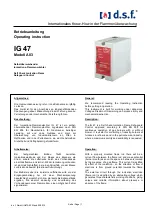
TECHNICAL SPECIFICATION
5. Product Installation and General Operation
5.1 Preliminary Operations
5.1.1 Internal Cleaning
Take care when cleaning the transparent cylinder, areas around the seals and surrounding metal work.
DO NOT clean the Bottle Sampler with Acetone or similar solvents that are not compatible with the seals. The recommended
cleaning fluid for internal flushing is listed on the website.
5.1.2 Pressurization and Opening
Always make sure that the top chamber is fully engaged before switching on the product.
Always make sure to vent the product of pressure prior to opening or restarting the pump (check that the Visiwink is green)
Turning on the pump with the unit pressurized can reduce the performance of the product and/or
cause irreparable damage
CAUTION
!
5.1.3 Bottle Cleanliness and Verification
To reduce the risk of your sample container affecting the contamination reading of your fluid sample, where possible try to use
bottles which have been cleaned and verified to the relevant ISO standards, these include but are not limited to:
DIN ISO 3722
Hydraulic Fluid Power, fluid sample containers, qualifying & controlling cleaning methods
DIN ISO 5884
Fluid systems and components, methods for system sampling and measuring the solid particle
contamination of hydraulic fluids
US FED STD 209E
Cleanroom standards, Class 100.000 minimum
ISO 14644-1
Cleanroom standards, ISO 8 minimum
How to clean and re-use your own bottles
For definitive guidance on the cleaning and verification of glassware refer to ISO3722 and ISO5884.
Below are some steps based on the above standards.
For use with Hydrocarbon/ Synthetic/Ester Fluid sampling:
1. Fill the container with 50 ml acetone, replace the cap, shake vigorously and drain to a waste container.
2. Fill to 50% of the container volume with 0.4 μm filtered Iso-propyl alcohol. Replace cap, shake vigorously and drain to a waste
container.
3. Fill to 50% of the container volume with 0.4 μm filtered Petroleum Ether. Replace cap, shake vigorously and drain to a waste
container.
4. Loosely replace the cap and do not remove until you are ready to take your next sample. (This allows any trace amounts of
Petroleum Ether to evaporate from the bottle and reduces the risk of any air-borne particles entering the container.)
5. Once complete, the fluid sample should be disposed of correctly and responsibly in line with local and international regulations.
Operators Guide
21
Summary of Contents for BS110
Page 1: ...Operators Guide BS110 BS500 Bottle Samplers ...
Page 2: ......
Page 6: ...Operators Guide 4 ...
Page 8: ...Operators Guide 6 ...
Page 11: ...OPERATOR S GUIDE Operators Guide 9 ...
Page 22: ...Operators Guide 20 ...
Page 32: ...Operators Guide 30 ...
Page 35: ......














































